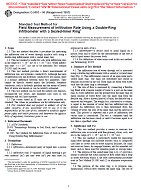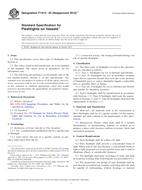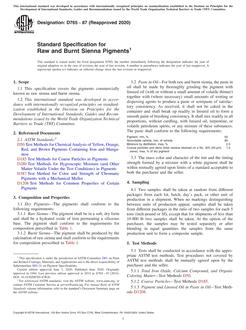1.1 These test methods are suitable for determining the flexural properties for any solid or hollow manufactured plastic lumber product of square, rectangular, round, or other geometric cross section that shows viscoelastic behavior. The test specimens are whole “as manufactured” pieces without any altering or machining of surfaces beyond cutting to length. As such, this is a test method for evaluating the properties of plastic lumber as a product and not a material property test method. Flexural strength cannot be determined for those products that do not break or that do not fail in the extreme outer fiber.
1.2 Test Method A designed principally for products in the flat or “plank” position.
1.3 Test Method B designed principally for those products in the edgewise or “joist” position.
1.4 Plastic lumber currently is produced using several different plastic manufacturing processes. These processes utilize a number of diverse plastic resin material systems that include fillers, fiber reinforcements, and other chemical additives. The test methods are applicable to plastic lumber products where the plastic resin is the continuous phase, regardless of its manufacturing process, type or weight percentage of plastic resin utilized, type or weight percentage of fillers utilized, type or weight percentage of reinforcements utilized, and type or weight percentage of other chemical additives.
1.4.1 Alternative to a single resin material system, diverse and multiple combinations of both virgin and recycled thermoplastic material systems are permitted in the manufacture of plastic lumber products.
1.4.2 Diverse types and combinations of inorganic and organic filler systems are permitted in the manufacturing of plastic lumber products. Inorganic fillers include such materials as talc, mica, silica, wollastonite, calcium carbonate, and so forth. Organic fillers include lignocellulosic materials made or derived from wood, wood flour, flax shive, rice hulls, wheat straw, and combinations thereof.
1.4.3 Fiber reinforcements used in plastic lumber include manufactured materials such as fiberglass (chopped or continuous), carbon, aramid and other polymerics; or lignocellulosic-based fibers such as flax, jute, kenaf, and hemp.
1.4.4 A wide variety of chemical additives are added to plastic lumber formulations to serve numerous different purposes. Examples include colorants, chemical foaming agents, ultraviolet stabilizers, flame retardants, lubricants, anti-static products, biocides, heat stabilizers, and coupling agents
1.5 The values stated in inch-pound units are to be regarded as the standard. The values given in brackets are for information only.
This standard does not purport to address all of the safety concerns, if any, associated with its use. It is the responsibility of the user of this standard to establish appropriate safety and health practices and determine the applicability of regulator limitations prior to use.
Note 1
There is no similar or equivalent ISO standard.
Product Details
- Published:
- 02/01/2005
- Number of Pages:
- 7
- File Size:
- 1 file , 200 KB
- Redline File Size:
- 2 files , 400 KB


